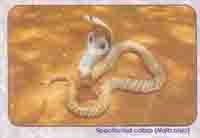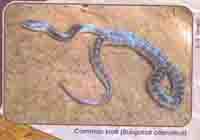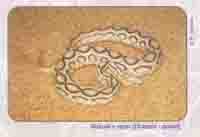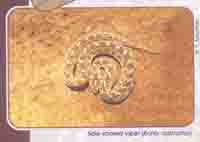|
(Continued from
last fortnight)
Which is the most dangerous snake of India?
Some features of incidents of snakebite, particularly in Indian conditions, are as follows:
(i) They are mostly in rural areas.
(ii) The majority of the bites happen at night.
(iii) The incidents are more common in the rainy season.
(iv) The majority of the victims are males.
(v) Most victims are in the age group 20 to 50.
(vi) Most of the bites are on the lower limbs, followed by the upper limbs. |
No one land snake of India qualifies to be counted as ‘the most dangerous’. The honours have to be shared by four of India’s 62 venomous snakes. Namely:
(i) The Indian cobra, i.e. the spectacled cobra and the monocled cobra (Naja naja and Naja kaouthia)
(ii)The common krait (Bungarus caeruleus)
(iii)The Russell’s viper (Daboia russelii)
(iv)The saw-scaled viper (Echis carinatus)
Among sea snakes, the hook-nosed sea snake may be reckoned as the most dangerous sea snake of India. It is the most widespread on the Indian coast, it is the commonest in its range and it has the most potent venom.
The total number of venomous snakes in India whose bite can be either fatal or life-threatening may be about 40, but the ‘Big Four’ account for the bulk of fatalities and life-threatening consequences of snakebite in India.
In 1981, WHO suggested the following categorisation of “snakes of medical significance”:
Class I: Snakes which commonly cause death or serious disability.
Class II: Uncommonly cause bites but are recorded to cause serious effects (death or local necrosis).
Class III: Commonly cause bites but serious effects are very uncommon.
The Russell’s viper, cobra and saw-scaled viper have been included in Class I and the common krait, hump-nosed pit viper, king cobra and mountain pit viper included in Class II. Class III has been left blank. This is not an improvement on the description ‘Big Four’ since all the four stand included in Classes I and II. Of the three new species included in Class II, only the hump-nosed pit viper and king cobra deserve some special recognition, even though they are certainly not on a par with the ‘Big Four’. Little is known about the venom of the mountain pit viper (Ovophis monticola) which has a limited range in Uttaranchal, Sikkim, West Bengal, Assam and the North-east.
The spectacled cobra (Naja naja)
Sanskrit & Hindi: Nag, Bengali: Naga gokurra, Tamil: Nallapambu, Malayalam: Moorkhan, Sarpam.

Spectacled cobra (Naja naja)
|
There are four species of cobra, conveniently called the Indian cobra, found in India.
The spectacled cobra (Naja naja)
The monocled cobra (Naja kaouthia)
The Central Asian cobra (Naja oxiana)
The Andaman cobra (Naja sagittifera)
Till recently, all these used to be grouped together as the same species, the Indian cobra or common cobra, Naja naja, of which they were believed to be different subspecies. Now each of these is considered as a distinct species.
Of these, the commonest is the spectacled cobra and it is found throughout mainland India excluding the Northeast. Seen in all kinds of terrain, it is also a good swimmer. It is often seen in or near agricultural fields, human habitations and granaries where it comes in search of rats, its favourite food. It is active by day and night and can be seen more commonly during evenings and early mornings. Apart from rats, frogs are also a principal item of its food.
The average length of the adult snake is about 3 ft. but it can reach a maximum length of more than 7 ft. It comes in different colours, shades of brown, yellow, grey or black. Its distinctive mark is the well-known ‘spectacle’ on the rear of the hood, i.e. on the dorsal side, which, though normally of a uniform design, can have variations also. In very rare cases, the ‘spectacle’ itself may be missing. On the underside of the hood are broad faint stripes. Above these stripes are two dark spots surrounded by white borders.
When provoked, the cobra will raise its forebody and spread it as a hood and may hiss. This display has to be taken seriously because, if it feels further threatened, it will strike.
Whitaker and Captain say that this snake, “though responsible for many bites, only a small percentage are fatal”. Next to the Russell’s viper, the cobra accounts for the largest number of snakebites in India. But, often, its bites are ‘dry bites’ with little venom injected.
If, by chance, a person comes across a clutch of the cobra’s eggs, he has to be careful because, unlike most other snakes, the female of the cobra does not abandon the eggs but stays with the eggs or guards the eggs, though it does not incubate the eggs. A cobra lurking in the vicinity of its eggs may be provoked to strike.
This cobra can be confused with the Indian rat snake (Ptyas mucosa) and they share common habitats since both have a decided preference for rats. But the hood and the ‘spectacle’ make the identification of the cobra easy.
This account of the behaviour of the spectacled cobra is more or less applicable to the monocled cobra also which can be distinguished from the former by the single eyeshaped mark on the back of its hood instead of the double mark in the former. Unlike the spectacled cobra which is found throughout mainland India (excluding the Northeast), the monocled cobra is found commonly only in North and Eastern India.
The Central Asian cobra is found only in a very limited area in Jammu & Kashmir, Himachal Pradesh and, probably, Punjab, and the Andaman cobra is found only in the Andaman islands. Both are
rare snakes even within their ranges.
The king cobra (Ophiophagus hnnah), undoubtedly the most magnificent of all snakes, does not belong to the same genus as the four cobras mentioned above.
The common krait (Bungarus caeruleus)
Hindi: Karayat, Marathi: Maniyar, Gujarati: Kala taro, Bengali: Kalaz Chitti, Tamil: Kattuviriyan, Yennai virian, Malayalam: Kattuviriyan.

Common krait (Bungarus caeruleus)
|
Though there are some seven species of krait in India, only two are common. Of these two, the only one widely occurring is the common krait (Bungarus caeruleus). The other is the banded krait (Bungarus fasciatus). The common krait occurs in fields, scrub jungles and is often found in the vicinity of human habitations. It is known to take up residence inside houses. It has an affinity for water and is often seen in water troughs in courtyards and gardens.
The common krait is generally not more than 3 ft. in length, the maximum length being about 5 ft. It is steel blue or bluish gray or glossy black or brownish black above with narrow white cross bars over its entire length. The fore-body may sometimes be free from the cross bars.
The common krait is nocturnal. Its behaviour is rather curious. Mark O’ Shea rightly calls it “the Dr. Jekyll and Mr. Hyde of the snake world”. During the day, it will be found to be very shy and timid and will rarely bite. But, at night, it is very active and quick to react. It can then be vicious and unpredictable and a person has to be very careful with it. It has a habit of rapidly striking to the side, which can prove to be treacherous. It enters huts and other human habitations, where persons sleeping on the floor are likely to get bitten. Especially in the cold season, the snake, seeking warmth, may snuggle close to a sleeping person or curl up on his mattress and, if he stirs or turns over in his sleep, he is likely to hurt the snake and provoke it into biting him.
Added to this is the fact that, unlike in the case of the cobra and the vipers, the bite of the common krait is generally painless and the sleeping person may not become aware of it or take note of it for what it really is and the consequent delay in treatment can prove to be fatal, particularly since its venom is extremely potent. As already noted, it has the most potent venom among all of our land snakes.
This snake is cannibalistic – that is, it feeds on snakes, even its own kind. Rodents, lizards and frogs are also eaten.
The Russell’s viper
(Daboia russelii)
Hindi: Kandar, Marathi: Ghonus, Gujarati: Chitar, Bangla: Bora, Tamil: Kannadi viriyan, Malayalam: Mandali

Russell’s viper
(Daboia russelii) |
Of the vipers found in India, species-wise the more numerous are the pit vipers, twenty of them, as against only three pitless vipers. These are the Russell’s viper (Daboia russelii), the saw-scaled viper (Echis carinatus) and the Levantine viper (Macrovipera lebetina). The last mentioned is uncommon and found only in a few localities in Kashmir.
The Russell’s viper is a common snake and is distributed throughout India. Appearance-wise it is over 3 feet in length and stout with three longitudinal series of conspicuous, large, brown or black oval marks on brown or yellowish brown body. The head is flat, and triangular with a ‘V’ shaped mark on it, with its pointed end towards the front. The tail is short and thin.
A young Indian rock python (Python molurus) and the common sand boa (Gongylophis conicus), both non-venomous, may sometimes be mistaken for the Russell’s viper but this snake, like all vipers, has a triangular head broader than the neck.
The Russell’s viper usually moves about in the night and is found in open, grassy areas, scrub jungles, rocky hillocks and thorny hedgerows. Its favourite food is rodents and that is the reason it is often found near human habitations.
Though vicious-looking, it bites only when provoked and then it may strike with great force often springing from the ground. Its usual reaction when disturbed is to hiss loudly (“like a pressure cooker”) and this is enough warning for anyone. But, the danger is when people walk about carelessly in the dark and with inadequate footwear and, if the snake which moves about in the night is unwittingly stepped on, it will strike – and strike fast and with no warning.
The bites from the Russell’s viper in India are far more in number than from cobras. The bite is not necessarily fatal though envenomation can have serious consequences unless treated promptly with antive nin.
The saw-scaled viper (Echis carinatus)
Hindi: Phoorsa, Gujarati: Tarachha, Bengali: Bankoraj, Tamil: Suruttai pamboo, Malayalam: Churutta

Saw-scaled viper (Echis carinatus) |
Appearances can be deceptive. This viper is a contrast to its relative, the Russell’s viper. Though a comparatively small and thin snake, being only about 1 to 1½ feet in length, it is far more vicious and its venom more toxic. The same dichotomy between size and the virulence of the venom is also seen in the king cobra vis-à-vis Indian cobra and in banded krait vis-à-vis common krait. When provoked, the saw-sclaed viper is also quicker to strike than the Russell’s viper.
As in other vipers, its head is triangular and broader than its neck. The tail is very short and thin. It is brown or brick-red or gray or sand-coloured with zigzag patterns on the back. There are many colour forms. The head, apart from being triangular in shape as in all vipers, has a distinctive arrow-shaped mark on it.
This is a very common snake found throughout mainland India except West Bengal and the Northeast.
This snake mostly moves about in the night and frequents warm roads or paths at night. It can also be seen basking in the morning sun. Mostly found in open, dry, sandy or rocky terrains, it rests under rocks or in thorny bushes during the day.
This snake is a side-winder1. It moves sideways by throwing its body into S-shaped curves.
It feeds on mice, lizards, frogs, scorpions and insects.
A distinctive feature of this snake is its threat display by producing a rasping sound. This it does by inflating its lungs and rubbing its saw-edged scales together. When agitated, it throws itself into a double coil. It is a good climber.
According to a WHO report, as against an average of 50% of ‘dry bites’ for all venomous snakebites together, the incidence of ‘dry bites’ by the saw-scaled viper is only 10%, which means that the chances of serious envenomation are much higher in bites by this species than in the case of other venomous snakes.
(To be concluded)
|